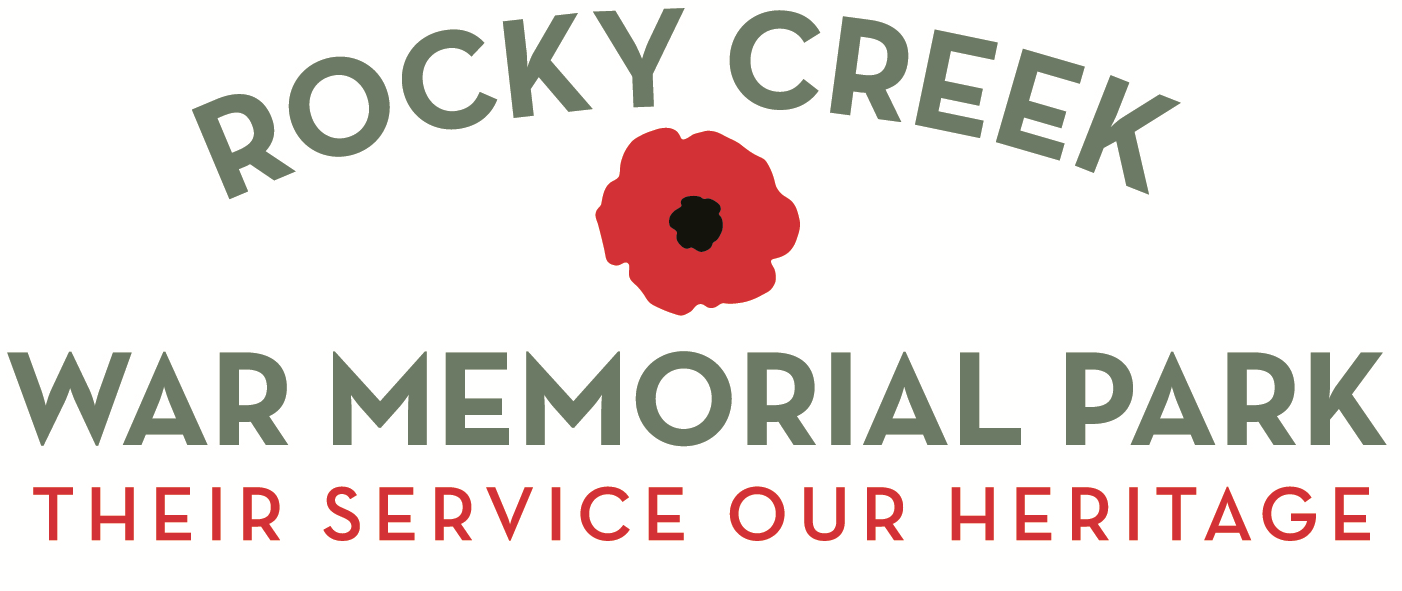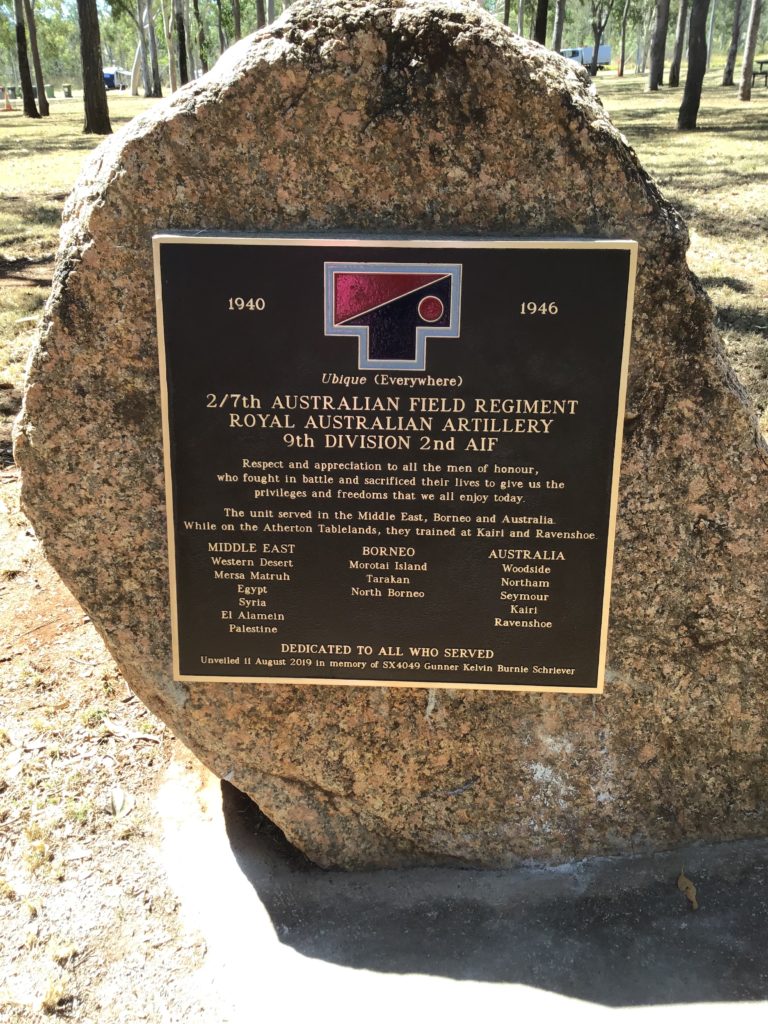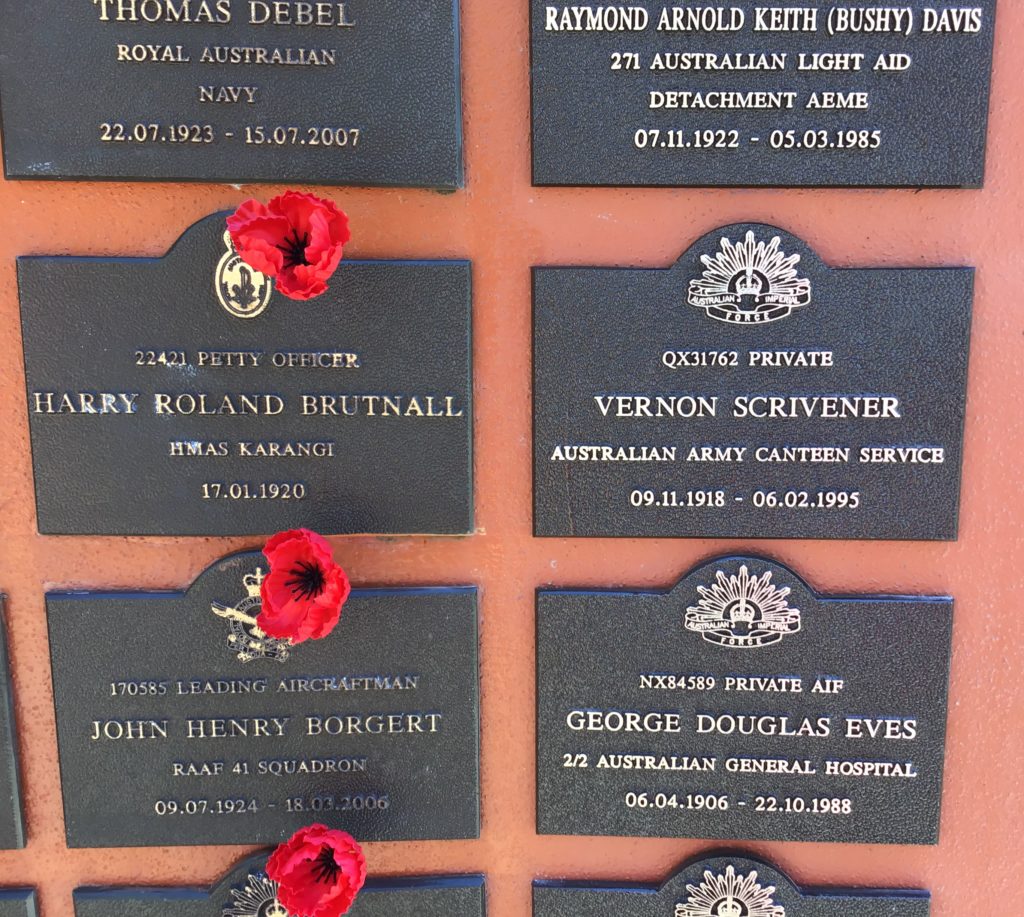A few kilometres along the Kennedy Highway north of Tolga, the Rocky Creek Memorial Park is situated on the 2/2nd Australian General Hospital laundry and medical stores site.
During World War II, the Tablelands area became the largest military base in Australia with camps at Tinaroo, Kairi, Atherton, Wongabel, Herberton, Wondecla, Ravenshoe and Mount Garnet. Rocky Creek was the site of the largest military hospital in the Southern Hemisphere — a 3000-bed hospital that treated over 60,000 patients from 1943 to 1945.

The first plaques dedicated in the park occurred on Victory in the Pacific (VP) Day in 1995. A special wall of remembrance was erected in 2009.
We are the custodian of the crown land and the park is developed and maintained in collaboration with the Rocky Creek War Memorial Park Committee.
Entry to the park is free. The toilets are open 8am–6pm.
© Chad Bromley
Every year in August, on the Sunday closest to VP Day 15 August, returned soldiers, their families and descendants gather to remember Victory in the Pacific and to take part in a dedication and unveiling ceremony. To commemorate 80 years since the end of WWII in the Pacific the 2025 VP Day Commemorative Service will be held on Sunday 17 August. Further events are being planned for this weekend.
10am dedication and unveiling of unit and personal plaques
11am commencement of memorial service
Donations of $5/vehicle/night contribute to the maintenance of the war memorial and are greatly appreciated. Donations can be made at the Atherton Tableland Visitor Information Centre on the corner of Silo and Herberton Roads in Atherton.
Camping Conditions
- Camping is permitted for fully self-contained vehicles only.
- Camping in tents, cars, camper trailers and small campervans is not permitted. We have the right to move any unsuitable vehicles.
- The camp host will provide a registration form to complete.
- Registration is valid for 72 hours from date of signature.
- No illegal dumping of black or greywater.
- Use bins provided.
- Do not use generators. The camp host may make exceptions, depending on conditions at the site.
- No open fires.
- Ensure dogs are always on a leash, never left unattended and their waste is collected
- Toilets are provided for visitors to the war memorial and are open 8am–6pm.
Definition of Fully Self-contained
(Source: Campervan and Motorhome Club (CMCA) of Australia Self-Contained Vehicle Policy)
Greywater
- No greywater is to be discharged from a self-contained vehicle unless allowable by local authorities or access to a dump point is impractical.
- Sinks hand basins and showers must drain to either an onboard (fitted) greywater tank or an external (non-fitted) greywater tank (tote).
- Totes must be connected to the vehicle by a drainage pipe with a watertight seal and have a working shut-off valve to avoid overflow.
- A tote may be used for discharging and transporting greywater from a vehicle to a disposal point, providing the vehicle discharge point has a permanently installed shut-off valve and the drainage pipe to the tote is connected by a watertight seal.
- When travelling, the portable greywater tote must be securely fastened within the confines of the vehicle so as not to cause a hazard.
- Liquid waste is not to be collected or removed in open buckets or containers.
Water Supply
- The vehicle shall have a freshwater tank or bladder specifically manufactured for the storage of potable water.
- The tank may be on-board (fitted) or external (non-fitted) and be of rigid construction with appropriate valves to prevent foreign matter or contaminants entering the tank.
- When travelling the tank must be securely fastened within the confines of the vehicle so as not to cause a hazard.
Sinks & Showers
- The vehicle must be fitted with an installed and plumbed sink. Additional sinks, hand basins and shower are optional.
- Every sink, hand basin and shower must be supplied with water from the fresh water tank, and must drain to a greywater tank. External showers used for ablutionary purposes and, in so doing create greywater, do not comply.
- External water outlets used for rinsing or filling are not seen as a greywater issue.
Toilets
- Blackwater is to be contained in holding tanks or cassettes, to be disposed of in a dump point or, if no appropriate facility is available, in accordance with the CMCA Bush Camping Code.
- The vehicle must be equipped with a toilet, installed in accordance with the manufacturer’s instructions.
- Portable toilets must be a proprietary brand manufactured for the specific purpose.
- When travelling, portable toilets must be securely fastened within the confines of the vehicle so as not to cause a hazard.
Rubbish
- You must have a sealable refuse container to hold rubbish for disposal.
Unit Plaques
There are more than 110 memorial plaques recognising the 6th, 7th and 9th Division AIF and supporting units. Plaques for military units stationed on the Atherton Tableland during WWII are positioned in the main plaque area, while plaques for other military units, groups and organisations are in the allied and community plaque area.
To be eligible, units must have been stationed on the Atherton Tablelands during WWII. Fees apply to the application and for installation.
Plaques may be funded by unit associations, ex-service organisations e.g. RSL, Saluting Their Service Commemorative Grants Program or other grant programs. Individuals and non-eligible organisations seeking funding must be auspiced by an eligible incorporated organisation who will apply on their behalf. The Department of Veterans’ Affairs’ Commemorative Grants Advisory Committee meets at least three times a year. Applications can be made at any time, but should be well in advance of a project or activity.

Plaque specifications
- generally 600 x 600mm
- bronze with raised lettering
- no acronyms e.g. 106 Casualty Clearing Station not 106 CCS
- brief unit history
- standard ACMF badge, if appropriate
- for World War II plaques, a standard Australian Commonwealth Military Forces rising sun badge (third pattern) including approval from the Department of Defence (usually a plaque manufacturers requirement)
- coloured corp/command/brigade/unit emblem if appropriate and with approval from the relevant brand managers (Army Brand Manager, Royal Australian Navy Brand Manager and Royal Australian Airforce Brand Manager).
- four lugs on back
Before the plaque has been produced, send a proof to us for approval.
Once the plaque has been produced, complete a plaque installation application, pay associated fees and send the plaque to:
Precincts Support Officer
Tablelands Regional Council
45 Mabel Street
PO Box 573
Atherton QLD 4883
Personal Plaques
Service personnel must have been in a unit when it was located on the Atherton Tablelands during WWII or resided on the Atherton Tablelands pre-and/or post-WWII. Proof of service and permission to use the Service badge for commemorative purposes from Department of Veteran Affairs Nominal Rolls are required at time of application. Fees apply to the application and for installation.
Funding may be available through RSL Queensland Far North District Office to assist with the cost of personal plaques. Further information from 0432 124 519 or kenneth.willoughby@rslqld.org.
Plaque Specifications
- 149 x 111mm
- maximum five lines of text
- standard ACMF badge at top (as pictured)
- two lugs/bosses on back.
Personal Plaque Application Process
- Apply (below) by 30 April each year.
- Application assessed and approval provided.
- You arrange production of plaque.
- Plaque provided to us for installation (around 1 August each year) and you pay installation fee.

